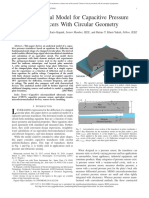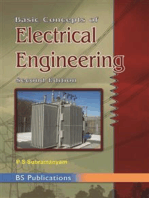FEM Simulation of Novel Thermal Microactuator: B.G.Sheeparamatti, J.S.Kadadevarmath, and M.S. Hebbal
FEM Simulation of Novel Thermal Microactuator: B.G.Sheeparamatti, J.S.Kadadevarmath, and M.S. Hebbal
Uploaded by
Pedro VargasCopyright:
Available Formats
FEM Simulation of Novel Thermal Microactuator: B.G.Sheeparamatti, J.S.Kadadevarmath, and M.S. Hebbal
FEM Simulation of Novel Thermal Microactuator: B.G.Sheeparamatti, J.S.Kadadevarmath, and M.S. Hebbal
Uploaded by
Pedro VargasOriginal Title
Copyright
Available Formats
Share this document
Did you find this document useful?
Is this content inappropriate?
Copyright:
Available Formats
FEM Simulation of Novel Thermal Microactuator: B.G.Sheeparamatti, J.S.Kadadevarmath, and M.S. Hebbal
FEM Simulation of Novel Thermal Microactuator: B.G.Sheeparamatti, J.S.Kadadevarmath, and M.S. Hebbal
Uploaded by
Pedro VargasCopyright:
Available Formats
INFORMATION PAPER
International Journal of Recent Trends in Engineering, Vol 1, No. 4, May 2009
FEM Simulation of Novel Thermal Microactuator
B.G.Sheeparamatti1, J.S.Kadadevarmath2, and M.S. Hebbal3
1
Basavashwar Engineering College/E & CE Dept, Bagalkot, India
Email: sheepar@yahoo.com
2
Karnataka University/ Electronics Dept, Dharwad, India
Email: jagadish_sk59@rediffmail.com
3
Basavashwar Engineering College/Automobile Engg. Dept, Bagalkot, India
Email: mshebbal3000@yahoo.com
Abstract— Microcantilevers are the basic and fundamental current density in the thick arm, and the thin arm heats up
MEMS based structures used in microsystems. more than the thick arm, which makes the thin arm to
Microcantilevers have been used both as sensors and bend. Thus, temperature produces thermal strain and
actuators. In this paper, modeling and simulation details of thermally induced deflections. This deflection makes the
a microcantilever for thermal actuation are presented. The
advantage of this actuator is, the tip of this actuator which
structure an actuator and specialty of this actuator is, its
actually drives some other object doesn’t gets heated and tip does not get heated to a high temperature.
hence can be used in any environment safely. The main The main objective of this work is to investigate the
objective of this work is to investigate the nature of microcantilever based actuator’s deflection for an applied
deflection of microcantilever based actuator for the applied potential difference across the base pads. In this work, a
potential difference across the base pads. In this device, two microcantilever based thermal actuator is modeled and
microcantilevers of different dimensions are considered and simulated. In the design two microcantilevers, which are
when these are subjected to same current, deflect joined at one point and are supported by big contact base
differently. The current density in the thin arm is greater pads are considered.
than the current density in the thick arm. Therefore, the
thin arm heats up more than the thick arm, which makes
the thin arm to bend. Thus, temperature produces thermal II. METHODOLOGY
strain and thermally induced deflections. This turns the The dimensions of the cantilevers are chosen with
microstructure into a thermal actuator. The amount of tip
arbitrary values. Finite element analysis is used in almost
deflection is a direct function of the applied potential
difference between the electrical connection pads. every engineering discipline. Earlier FEA packages were
Therefore, the amount of tip deflection can be calibrated as limited to linear, static stress analysis only. Now they
a function of applied voltage. Additional objectives of this have been extended to include nonlinear static stress,
work are to obtain voltage, temperature and displacement dynamic stress, fluid flow, heat transfer, electric,
plots. Increasing the applied voltage in the model developed electrostatic, magnetic, etc. These capabilities are
in ANSYS/Multiphysics, resulted in increase in the combined to perform coupled-field analysis that consider
deflection. This is because of direct relationship between the multiple physical phenomena and are tightly integrated
applied voltage, current density, temperature developed and within a CAD interface. The finite element method is
deflection.
very efficient since it can be applied to any geometry, any
Index Terms— Microcantilever, thermal microactuator, set of material properties, and loading conditions as long
FEM Analysis, ANSYS/ Multiphysics, MEMS as the appropriate constitutive relationships and
equilibrium conditions are met. One more advantage of
I. INTRODUCTION this FEA tool is, it is not restricted by size, and one can
use the so-called zoom feature in finite element meshing
A beam fixed at one end and free at the other end is to describe a miniature MEMS device. Hence many
called a cantilever and a cantilever whose dimensions are researchers have used this finite element method for
in the range of microns is termed as microcantilever. As modeling MEMS devices. The model was created
the dimensions of the cantilevers are miniaturized, the selecting the disciplines structural, thermal and electrical
ratios of length to area and area to volume will be of ANSYS/Multiphysics [4]. Fig. 1 shows the structure of
drastically changed and these changes alter the relative the microactuator model.
effects of various physical parameters in an altogether Two cantilever beams of different dimensions were
dramatic way than conventional macro cantilevers. modeled using coupled-field element type SOLID98 [4].
Microcantilevers are the basic and fundamental MEMS This element has thermal, electrical and structural
based structures used for microsystems. They have been properties for 3D model. As all the dimensions are taken
used for both sensing and actuating applications [1]. in microns, Young’s modulus, resistivity, and thermal
Analysis of these microcantilevers is easy mainly because conductivity is also taken in µMKSV units. The
analytical equations can be applied easily, and can also be modeled actuator requires analysis with a coupled-field
very easily implemented in FEM tools like ANYSIS / multiphysics analysis that accounts for the interaction
Multiphysics [2, 3]. In this device, two microcantilevers
of different dimensions are joined and when they are
subjected to same current, deflect differently. This is
because, current density in the thin arm is greater than the
79
© 2009 ACADEMY PUBLISHER
INFORMATION PAPER
International Journal of Recent Trends in Engineering, Vol 1, No. 4, May 2009
Figure 1. Model of the Thermal Microactuator. Figure 3. Stress distribution without ‘U’ notch
(coupling) between thermal, electrical, and structural
fields. The tool used for design and simulation is III. REESULTS AND DISSUSSIONS
ANSYS/Multiphysics. The actuator is modeled using
multiphysics module of ANSYS, which allows the Initially, physical loads were applied to the
analysis of resulting stresses and deflections. Fig. 2 microcantilever tip and it behaved linearly, that is, higher
shows the meshed model of the microcantilever based the applied load, larger the deflection. In a similar
actuator. The developed finite element model consists of fashion increasing the applied voltage, resulted in
10978 elements, 16125 nodes and each node has five increase in the deflection, because of the direct
degrees of freedom. relationship between the applied voltage, current density,
After meshing the model and setting the temperature to temperature generated and deflection. “Fig. 5” shows the
300 C, voltage is applied between two electrical deflection and the Fig. 6 shows the temperature at
connection pads. Arresting the base of the contact pads different positions of the cantilever pairs considered.
in all directions, analysis is done and for this analysis, “Fig. 5” shows that highest strain occurred at the tip of
polysilicon material is used to build the actuator. This the beam.
ensured that the bases don’t move during the Applying 3V, 4V, 5V, 6V, and 7V to the developed
administration of the electrical voltage so that the actual model, resulting maximum deflection and maximum
deflection can be observed. The adequacy of the number temperature are recorded. Fig. 7 shows the graph of both
of elements used is confirmed by convergence of maximum temperature and deflection in microns. It
deflection at the tip of the cantilever beam. After shows the necessity of exact analysis of deflection of
analyzing the stresses at the base of the cantilevers as microcantilever in response to the applied
shown in the Fig. 3, a ‘U’ notch was introduced at voltage/current.
location ‘A’ as shown in the Fig. 4. This resulted in Similarly by changing cross section of the smaller
reduction of maximum principle stress by about 13% [5]. cantilever, some readings can be taken and finding the
The main advantage of this actuator is, the tip of this optimum cross section is a challenge. Stress distribution
actuator does not get heated to a high temperature and at the U notch and reducing the stress can also be taken
hence do not pass the heat to the subsequent part which is up as a separate work. Here, according to the required
to be driven. Thus this actuator has special advantage voltage actuation, one can increase the deflection per
than such cantilever based actuators. voltage, by setting optimum dimension to U-notch
keeping local stress value below permissible stress.
Figure 2. Mesh Model of the Thermal Microactuator Figure 4. Stress distribution with ‘U’ notch
80
© 2009 ACADEMY PUBLISHER
INFORMATION PAPER
International Journal of Recent Trends in Engineering, Vol 1, No. 4, May 2009
2000 10
1800 9
temp
1600 8
def
1400 7
DEFL. ( Micron)
TEMP( OC)
1200 6
1000 5
800 4
600 3
400 2
200 1
0 0
3 4 5 6 7
VOLTS
Figure 5. Deflection of the thermal Microactuator
IV. CONCLUSIONS Figure 7. Graph of Max. Temperature and Deflection against
different voltages
This type of thermal actuators can be used to move
micro objects/devices, and an array of such actuators can
be used to produce large effects. The fact that the tip of REFERENCES
this actuator does not get heated to a high temperature
[1] M.J.Sepaniak, P.G.Datskos, N.V.Lavrik, C.A.Tripple,
makes this actuator important to handle bio/chemical “Microcantilever transducers:A new approach in Sensor
samples. Technology”, Analytical Chemistry, 74,568A(2002).
Thus the actuator has added advantage compared to [2] Sheeparamatti B.G, Hebbal M.S, Kadadevaramath J.S,
such similar actuators. “FEM modeling of MEMS based sensor for sensing
These results can be used to develop optimal Antibody/Antigen” Proceedings of International
dimensions for voltage induced thermal actuators. This Conference on materials, structures and systems organized
simulation helps to study the possible changes that can by Institute of Smart Structures and Systems(ISSS), IISc
occur in microstructures compared to macrostructures. Bangalore July 28-30, 2005
One can focus on different structures and different [3] Sheeparamatti B. G, Hebbal M. S, Rajeshwari
Sheeparamatti, Math V. B, Kadadevaramath J. S,
materials for wide range of applications such as
“Simulation of Biosensor using FEM”,
biosensors with thermal actuators, and other sensing proceedings of the International Conference on MEMS
systems integrated with sensors and actuators. This can (IMEMS-06), NTU Singapore during 9th to 12th May
lead to exploitation of full potential of microcantilevers in 2006
micro-electro-mechanical system devices. One can [4] Jan Mehner , Juergen Wibbeler, “ANSYS Multiphysics
convert this design to an efficient actuator which can capabilities for MEMS Modeling and Simulation”,
provide a maximum deflection for a minimum voltage ANSYS solutions, Vol. 3, Number 2.
applied, by using appropriate optimizing techniques. This [5] B. G. Sheeparamatti, J. S. Kadadevarmath, M.S.Hebbal
requires changing the geometry and getting data for all “FEM Simulation of Microcantilever based Thermal
Microactuator” National Conference on Recent
those geometries and applying some optimization
Advances in Design Engineering (RADE 2007) organized
methods. By Manipal Institute of Technology Manipal during
February 22 – 24, 2007.
Figure 6. Temperature distribution at different parts of the Thermal
Microactuator
81
© 2009 ACADEMY PUBLISHER
You might also like
- LIFEPAK 1000 Service Manual PDFDocument174 pagesLIFEPAK 1000 Service Manual PDFanibal bravo100% (2)
- Schaum's Outline of Electromagnetics, 4th EditionFrom EverandSchaum's Outline of Electromagnetics, 4th EditionRating: 1 out of 5 stars1/5 (2)
- Michael Hall - Secrets of Personal Mastery (NLP)Document5 pagesMichael Hall - Secrets of Personal Mastery (NLP)swetalogin0% (1)
- Grade 8 Summative Test (Matter) NAME: - YEAR & SEC.: - DATE: - SCOREDocument3 pagesGrade 8 Summative Test (Matter) NAME: - YEAR & SEC.: - DATE: - SCOREmenchie ismaelNo ratings yet
- An Introduction To Language and Linguistics Additional Exercises - Chapter 1Document9 pagesAn Introduction To Language and Linguistics Additional Exercises - Chapter 1Muhammad AakashNo ratings yet
- A Review On Actuation and Sensing Techniques For MEMS-based MicrogrippersDocument14 pagesA Review On Actuation and Sensing Techniques For MEMS-based MicrogrippersraghulthoppaeNo ratings yet
- Design and Simulation of Electrothermally Activated Bidirectional Microtweezer Using PMMA For Biomedical ApplicationsDocument4 pagesDesign and Simulation of Electrothermally Activated Bidirectional Microtweezer Using PMMA For Biomedical ApplicationstheijesNo ratings yet
- Review of Electrothermal Actuators and ApplicationDocument28 pagesReview of Electrothermal Actuators and ApplicationvuonglupNo ratings yet
- Fracture Strength and Fatigue of Polysilicon Determined by A Novel Thermal ActuatorDocument7 pagesFracture Strength and Fatigue of Polysilicon Determined by A Novel Thermal ActuatorIhsanNo ratings yet
- Brouwer 2019 Supercond. Sci. Technol. 32 095011Document13 pagesBrouwer 2019 Supercond. Sci. Technol. 32 095011roshanNo ratings yet
- JMEMS16 VO2 MEMS MirrorDocument8 pagesJMEMS16 VO2 MEMS MirrorxyzxxknknNo ratings yet
- Mems Ass - QuesDocument2 pagesMems Ass - QuesgeethaNo ratings yet
- ICMEMS2014 2382 MaghsoudiDocument6 pagesICMEMS2014 2382 MaghsoudiRahma elizaNo ratings yet
- Comparative Study of Perforated RF Mems Switch: SciencedirectDocument7 pagesComparative Study of Perforated RF Mems Switch: SciencedirectAnkur SaxenaNo ratings yet
- Optimization of Static and Dynamic Travel Range of Electrostatically Driven Microbeams Using Particle Swarm OptimizationDocument16 pagesOptimization of Static and Dynamic Travel Range of Electrostatically Driven Microbeams Using Particle Swarm OptimizationAndré SilveiraNo ratings yet
- Finite Element Analysis of Micro - Electro - Mechanical Systems by Using The ANSYS SoftwareDocument6 pagesFinite Element Analysis of Micro - Electro - Mechanical Systems by Using The ANSYS SoftwareSatyajit C DhaktodeNo ratings yet
- Hamedi 2012Document5 pagesHamedi 2012Đức HiếuNo ratings yet
- Design Study For An Electro-Thermally Actuator For MicromanipulationDocument8 pagesDesign Study For An Electro-Thermally Actuator For MicromanipulationIonescu ViorelNo ratings yet
- 3 - Joglekar2011Document10 pages3 - Joglekar2011Flávia Gonçalves FernandesNo ratings yet
- Electro-Thermal Modeling, Aging and Lifetime Estimation of Power Electronic MOSFETSDocument4 pagesElectro-Thermal Modeling, Aging and Lifetime Estimation of Power Electronic MOSFETSIsabela FangoniloNo ratings yet
- 1.1 General Introduction: Modeling and Simulation of Micro-Electromagnetic ActuatorDocument74 pages1.1 General Introduction: Modeling and Simulation of Micro-Electromagnetic Actuatorbasavaraj hagaratagiNo ratings yet
- Energy HarvestorDocument9 pagesEnergy HarvestorashishNo ratings yet
- Optimization and Fabrication of A Double Embedded Microcantilever Based On FEM Geometry AnalysisDocument2 pagesOptimization and Fabrication of A Double Embedded Microcantilever Based On FEM Geometry AnalysisSantiago Garcia-Alonso MontoyaNo ratings yet
- Thermal Sensor10Document4 pagesThermal Sensor10rasoulNo ratings yet
- Micromachines 12 00622 v2Document7 pagesMicromachines 12 00622 v2Pedro VargasNo ratings yet
- Thermal MEMSDocument29 pagesThermal MEMSSmita PradhanNo ratings yet
- Electromechanical Modelling and Stress Analysis ofDocument9 pagesElectromechanical Modelling and Stress Analysis ofTwins TwinNo ratings yet
- Senzor - Balavalad 2017 Ijca 913554Document9 pagesSenzor - Balavalad 2017 Ijca 913554Andrijana KuharNo ratings yet
- Chapter 8Document32 pagesChapter 8mulukenuniNo ratings yet
- Modeling of Electro-Thermal Microbolometer For Thermal ImagingDocument2 pagesModeling of Electro-Thermal Microbolometer For Thermal ImagingVlad MarcuNo ratings yet
- DYNAMIC ANALYSIS of MICRO-ELECTRO-MECHANICAL SYSTEMS - SHI - 1998 - International Journal For Numerical Methods in Engineering - Wiley Online LibraryDocument24 pagesDYNAMIC ANALYSIS of MICRO-ELECTRO-MECHANICAL SYSTEMS - SHI - 1998 - International Journal For Numerical Methods in Engineering - Wiley Online LibraryKajal KhanNo ratings yet
- Vibrational Energy Harvesting MEMS ReviewDocument9 pagesVibrational Energy Harvesting MEMS Review胡鈺堂No ratings yet
- Shikida2017 Article FabricationAndFlow-sensorAppliDocument9 pagesShikida2017 Article FabricationAndFlow-sensorAppliyohannesNo ratings yet
- Modeling Magnetic Devices Using SPICE Application To Variable InductorsDocument8 pagesModeling Magnetic Devices Using SPICE Application To Variable InductorsRahul BishtNo ratings yet
- Jsen 2017 2756921Document11 pagesJsen 2017 2756921Maryam MaryamNo ratings yet
- Large-Stroke Capacitive MEMS Accelerometer Without Pull-In: Meysam Daeichin, Ronald N. Miles, and Shahrzad TowfighianDocument10 pagesLarge-Stroke Capacitive MEMS Accelerometer Without Pull-In: Meysam Daeichin, Ronald N. Miles, and Shahrzad TowfighianRanjit ReddyNo ratings yet
- S1063739721070027Document6 pagesS1063739721070027ynader2001No ratings yet
- Articulo N1 - MEMS Surface Micromachined AccelerometerDocument32 pagesArticulo N1 - MEMS Surface Micromachined AccelerometerCARLOS SEBASTIAN BLAS PERALTANo ratings yet
- Abb Ag CN12Document3 pagesAbb Ag CN12Francisco ViglusNo ratings yet
- Sensors 21 03117 v2Document23 pagesSensors 21 03117 v2mohammadreza.hajipour98No ratings yet
- Design of Mems Based Capacitive AccelerometerDocument4 pagesDesign of Mems Based Capacitive AccelerometerJoseph GeorgeNo ratings yet
- Sensors 19 02705Document14 pagesSensors 19 02705mohammadreza.hajipour98No ratings yet
- Active Thermal Controle - CompressedDocument13 pagesActive Thermal Controle - CompressedYC PRONo ratings yet
- Analysis of Temperature Stability and Change of Resonant Frequency of A Capacitive MEMS AccelerometerDocument13 pagesAnalysis of Temperature Stability and Change of Resonant Frequency of A Capacitive MEMS Accelerometermohammadreza.hajipour98No ratings yet
- Ee6007 Mems Question BankDocument4 pagesEe6007 Mems Question Bankvirudaianand0% (1)
- MEMS Sensors PaperDocument5 pagesMEMS Sensors PaperM.Aimal KhiamNo ratings yet
- RF Series Switch PDFDocument6 pagesRF Series Switch PDFAnonymous ybl4y5RIlNo ratings yet
- A High Force Low Area MEMS Thermal ActuatorDocument6 pagesA High Force Low Area MEMS Thermal ActuatorsolarprismNo ratings yet
- Mechatronics: Soheil Talebian, Ghader Rezazadeh, Mohammad Fathalilou, Behrooz ToosiDocument8 pagesMechatronics: Soheil Talebian, Ghader Rezazadeh, Mohammad Fathalilou, Behrooz ToosijsnbNo ratings yet
- Jun Zeng - Electrohydrodynamic Modeling and Its Applications To Microfluidic DevicesDocument10 pagesJun Zeng - Electrohydrodynamic Modeling and Its Applications To Microfluidic DevicesHutsDMNo ratings yet
- Unit 5 Module 1Document17 pagesUnit 5 Module 1vobej77054No ratings yet
- A New Model of Electromechanical Relays For Predicting The Motion and Electromagnetic DynamicsDocument9 pagesA New Model of Electromechanical Relays For Predicting The Motion and Electromagnetic DynamicsALFREDO MINDIOLANo ratings yet
- Thermal Analysisof Power Cables Using Finite Element Methodand Currentcarryingcapacityevaluation Ijee 2244Document9 pagesThermal Analysisof Power Cables Using Finite Element Methodand Currentcarryingcapacityevaluation Ijee 2244Vinciushfb2No ratings yet
- Thermal Analysisof Power Cables Using Finite Element Methodand Currentcarryingcapacityevaluation Ijee 2244Document9 pagesThermal Analysisof Power Cables Using Finite Element Methodand Currentcarryingcapacityevaluation Ijee 2244Vinciushfb2No ratings yet
- Analysis of Localized Dissipation Factor MeasuremeDocument5 pagesAnalysis of Localized Dissipation Factor MeasuremeAdamTrisnoizeAgustianNo ratings yet
- Thermo-Mechanical Behavior of Shape Memory Alloy Spring Actuated Using Novel Scanning Technique Powered by Ytterbium Doped Continuous Fiber LaserDocument14 pagesThermo-Mechanical Behavior of Shape Memory Alloy Spring Actuated Using Novel Scanning Technique Powered by Ytterbium Doped Continuous Fiber Lasernaren2110208No ratings yet
- New Composite ThermoelectricDocument5 pagesNew Composite ThermoelectricwhmonkeyNo ratings yet
- An Analytical Model For Capacitive Pressure Transducers With Circular GeometryDocument9 pagesAn Analytical Model For Capacitive Pressure Transducers With Circular GeometryShuvam5 GuptaNo ratings yet
- Calculation of Losses in Ferro - and Ferrimagnetic Materials Based On The Modified Steinmetz Equation KIRANDDocument7 pagesCalculation of Losses in Ferro - and Ferrimagnetic Materials Based On The Modified Steinmetz Equation KIRANDkiranNo ratings yet
- Wygant 2018Document9 pagesWygant 2018morris.goe.deNo ratings yet
- Nuclear Microbattery For MEMS Devices: January 2002Document13 pagesNuclear Microbattery For MEMS Devices: January 2002AmarjeetNo ratings yet
- 506ampacity PDFDocument9 pages506ampacity PDFCarlos Lino Rojas AgüeroNo ratings yet
- Basic Concepts of Electrical EngineeringFrom EverandBasic Concepts of Electrical EngineeringRating: 5 out of 5 stars5/5 (1)
- Micromachines 12 00622 v2Document7 pagesMicromachines 12 00622 v2Pedro VargasNo ratings yet
- PHD Scholarships: Swiss Government Excellence ScholarshipsDocument4 pagesPHD Scholarships: Swiss Government Excellence ScholarshipsPedro VargasNo ratings yet
- NitruroSi PDFDocument76 pagesNitruroSi PDFPedro VargasNo ratings yet
- (Methods in Bioengineering) Prof. Dr. Karl Otto Greulich (Auth.) - Micromanipulation by Light in Biology and Medicine - The Laser MicrobeamDocument307 pages(Methods in Bioengineering) Prof. Dr. Karl Otto Greulich (Auth.) - Micromanipulation by Light in Biology and Medicine - The Laser MicrobeamPedro VargasNo ratings yet
- PASCO WA9314C Exp Guide Microwave OpticsDocument42 pagesPASCO WA9314C Exp Guide Microwave OpticsPedro VargasNo ratings yet
- B.E. CSE FinalDocument124 pagesB.E. CSE FinalbalaNo ratings yet
- Sow English Year 4 2023-2024Document12 pagesSow English Year 4 2023-2024AnKadim AwisNo ratings yet
- Subject Pronouns & Possessive Adjectives & Possessive - S'Document3 pagesSubject Pronouns & Possessive Adjectives & Possessive - S'Răzvan Adrian CârcuNo ratings yet
- 687Document9 pages687Fernando MoyaNo ratings yet
- 30936393-MitDocument88 pages30936393-MitJoy Alejandro HakcholnaNo ratings yet
- Traffic Bifurcation Between DPDK and Linux Kernel Using DPDMUXDocument9 pagesTraffic Bifurcation Between DPDK and Linux Kernel Using DPDMUXpuny potNo ratings yet
- Ripper Tip D11Document2 pagesRipper Tip D11Max SashikhinNo ratings yet
- GaclistDocument7 pagesGaclistNdy BeatlesNo ratings yet
- Ucpb vs. AboitizDocument5 pagesUcpb vs. AboitizTinersNo ratings yet
- Meeting Its TypesDocument27 pagesMeeting Its TypesjulunderNo ratings yet
- Review of Related Study and LiteratureDocument4 pagesReview of Related Study and LiteratureRyan Carl IbarraNo ratings yet
- 5 de Thi Hoc Ki 1 Tieng Anh 6 Ilearn Smart World Co Dap An Va Loi Giai Chi Tiet 1671159396Document62 pages5 de Thi Hoc Ki 1 Tieng Anh 6 Ilearn Smart World Co Dap An Va Loi Giai Chi Tiet 1671159396hậu útNo ratings yet
- aQUACULTUERDocument207 pagesaQUACULTUERJf JohnNo ratings yet
- Genius Makers (2021Document15 pagesGenius Makers (2021saqlainsaquib.innovioNo ratings yet
- BPNTC - Activity InternetDocument2 pagesBPNTC - Activity InternetchelseaNo ratings yet
- MOWE-UNDP 2014 - Assessment of Groundwater Resources of LebanonDocument47 pagesMOWE-UNDP 2014 - Assessment of Groundwater Resources of LebanonNassif Abi AbdallahNo ratings yet
- Q4 Exam Hele4 Answer KeyDocument3 pagesQ4 Exam Hele4 Answer KeySherry Ann ArbutanteNo ratings yet
- Insulation SpecificationDocument19 pagesInsulation SpecificationmnsNo ratings yet
- Semi-Detailed Lesson Plan in Mathematics 8Document2 pagesSemi-Detailed Lesson Plan in Mathematics 8Jessa Mae CobradoNo ratings yet
- CSEC IT January 2018 P2Document19 pagesCSEC IT January 2018 P2Trevor G. Samaroo100% (1)
- Open DEFORM™-3D. Make A New Problem Under "Problem" Directory. Problem Setup Window Will Open. Select The Ring Rolling Guiding TemplateDocument13 pagesOpen DEFORM™-3D. Make A New Problem Under "Problem" Directory. Problem Setup Window Will Open. Select The Ring Rolling Guiding Templatevincent02hk_57881301No ratings yet
- Freight Terminals: CharacteristicsDocument6 pagesFreight Terminals: Characteristicskim jeonNo ratings yet
- Kasus IvDocument3 pagesKasus IvRizka DestianaNo ratings yet
- Brian Walker: Work ExperienceDocument3 pagesBrian Walker: Work ExperiencetransNo ratings yet
- Cell Organelle Structure and Function Dhruv Tejusinghani P1Document6 pagesCell Organelle Structure and Function Dhruv Tejusinghani P1GamingWithDhruv100% (2)
- Broiler Management Handbook 2nd EditionDocument32 pagesBroiler Management Handbook 2nd EditionManlike SasNo ratings yet





























































































